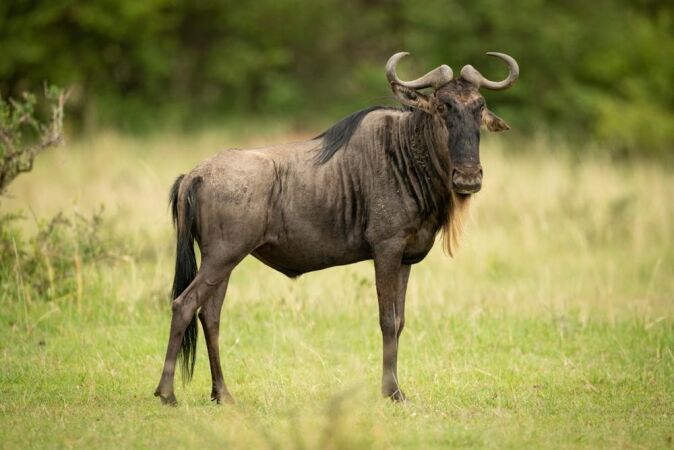

When we consider African game hunting in Africa, one of the popular choices for hunters is the blue wildebeest (Connochaetes taurinus). The blue wildebeest is scattered across the African continent and found in Botswana, Tanzania, South Africa, Mozambique, Angola, and Kenya. It has also been successfully reintroduced in Namibia, where it was previously extinct. It is listed as an animal of “least concern” by the International Union of Conservation of Nature (IUCN).
They can be found in various habitats, from overgrazed areas with dense bush, to open woodlands and floodplains in south, central, and eastern Africa. Their preferred habitat is short-grassed plains that border savannas, in areas that are neither too wet nor too arid. They are one of the most widely distributed species, as well as the most commonly targeted antelopes for hunters on an African plains game hunting safari. They do migrate, which seems to depend on the rainfall pattern and grass available for consumption.
The blue wildebeest travels in herds, ranging in size from a couple to thousands of animals. This makes targeting a specific blue wildebeest bull quite a challenge on a hunting safari and careful concentration is required.
These big game antelopes breed towards the end of the rainy season, with the female gestating for 8.5 months. The female gives birth to one calf in the middle of the herd and the offspring is usually born in the middle of the day and can stand within minutes. The calf stays with its mother until leaving her to join a juvenile herd when it is around eight months old.
The blue wildebeest is an herbivorous grazer and prefers sweet grasses, although they will also follow other antelopes that consume the drier, longer variants of grasses. They are most active early in the day and later in the afternoon while resting during the hotter section of the day.
They are preyed on by numerous carnivores, including Nile crocodiles, lions, and hyenas, while wild dogs are also known to target calves, elderly, and sick animals in the herd. These African plains game antelopes can reach impressive speeds of up to 80 miles an hour to outrun their attackers.
Name:
Connochaetes Taurinus
Male Weight:
370-900 pounds
Male Shoulder Height:
43-57 inches
Range:
Central, Southern and Eastern Africa
Gestation Period:
8.5 months
Life span:
20 years
Name:
Felis Silvestris Libyca
Male Weight:
7-9 Pounds
Male Shoulder Height:
9 Inches
Range:
Southern and West Africa
Mating Season:
Early in the Year. Gestation Period of +-56 Days
Life span:
Up to 16 years
African game hunting in Africa, one of the popular choices for hunters is the blue wildebeest
While identifying a blue wildebeest on a hunting safari is relatively easy to accomplish, actually hunting them is a different challenge altogether! They are medium to large antelopes, with heavily built forequarters and reach up to 8 feet in length. Males weigh up to 370-900 pounds, standing between 43-57 inches at the shoulder. Female blue wildebeest are lighter and smaller, weighing 310-570 pounds. They have a distinct muzzle and both sexes have horns, with the male’s horns being thicker at the base. The adults’ coats range in color from a deep bluish-gray to a lighter-gray and even a shade of grayish-brown. Males have a darker coloring than females. Calves are both a yellowish-brown color and start developing their adult coloring at two months.
One of the joys of hunting in Africa is that there is always a challenge heading your way! Hunting the blue wildebeest requires patience stamina, and the will to listen to your PH when they identify a good African plains game trophy from the hundreds of animals in the herd! The best time of day to hunt the blue wildebeest is early in the morning or late afternoon as they graze, and when they are most active, especially if you plan on using the walk-and-stalk method. Another popular method is to build a blind overlooking the waterhole where they come to drink and target them from this position.
The blue wildebeest has earned the reputation of being one of the most difficult African plains game animals to hunt. This challenging hunt will have you improving your stealth mode, experiencing Africa’s wildlife and bushveld as never before, and wondering why you didn’t arrange this memorable hunting adventure ages ago!
Blue wildebeest hunting should not be conducted with any caliber less than .270. Flat shooting .300 magnums loaded with 200 grains to 220 grains are the best option. A .308 with a bullet weighing not less than 165 grains can be used, but shot placement is critical. Blue Wildebeest are exceptionally tough and are known for their ability to “eat lead.” The hunter need not be afraid to use something even bigger such as a .338, .375, or a .416 Rigby.
Search from our range of Hunts across various popular destinations in Africa.
Find A Hunt